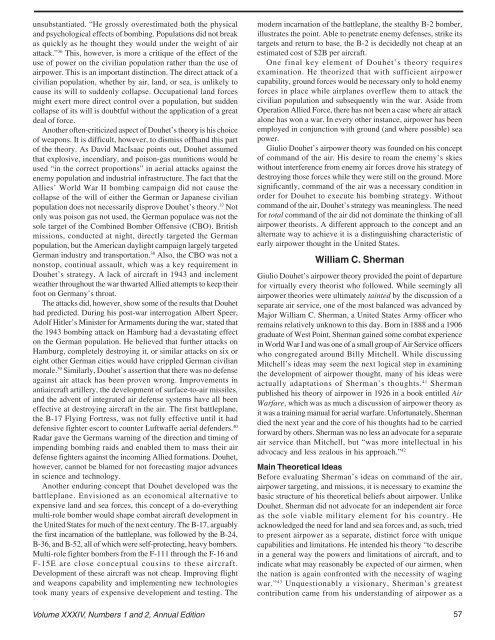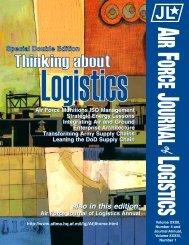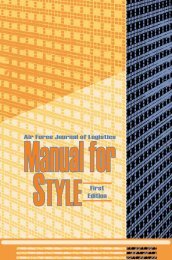Clearing the Air: Airpower Theory and Contemporary Airpower
Clearing the Air: Airpower Theory and Contemporary Airpower
Clearing the Air: Airpower Theory and Contemporary Airpower
Create successful ePaper yourself
Turn your PDF publications into a flip-book with our unique Google optimized e-Paper software.
unsubstantiated. “He grossly overestimated both <strong>the</strong> physical<br />
<strong>and</strong> psychological effects of bombing. Populations did not break<br />
as quickly as he thought <strong>the</strong>y would under <strong>the</strong> weight of air<br />
attack.” 36 This, however, is more a critique of <strong>the</strong> effect of <strong>the</strong><br />
use of power on <strong>the</strong> civilian population ra<strong>the</strong>r than <strong>the</strong> use of<br />
airpower. This is an important distinction. The direct attack of a<br />
civilian population, whe<strong>the</strong>r by air, l<strong>and</strong>, or sea, is unlikely to<br />
cause its will to suddenly collapse. Occupational l<strong>and</strong> forces<br />
might exert more direct control over a population, but sudden<br />
collapse of its will is doubtful without <strong>the</strong> application of a great<br />
deal of force.<br />
Ano<strong>the</strong>r often-criticized aspect of Douhet’s <strong>the</strong>ory is his choice<br />
of weapons. It is difficult, however, to dismiss offh<strong>and</strong> this part<br />
of <strong>the</strong> <strong>the</strong>ory. As David MacIsaac points out, Douhet assumed<br />
that explosive, incendiary, <strong>and</strong> poison-gas munitions would be<br />
used “in <strong>the</strong> correct proportions” in aerial attacks against <strong>the</strong><br />
enemy population <strong>and</strong> industrial infrastructure. The fact that <strong>the</strong><br />
Allies’ World War II bombing campaign did not cause <strong>the</strong><br />
collapse of <strong>the</strong> will of ei<strong>the</strong>r <strong>the</strong> German or Japanese civilian<br />
population does not necessarily disprove Douhet’s <strong>the</strong>ory. 37 Not<br />
only was poison gas not used, <strong>the</strong> German populace was not <strong>the</strong><br />
sole target of <strong>the</strong> Combined Bomber Offensive (CBO). British<br />
missions, conducted at night, directly targeted <strong>the</strong> German<br />
population, but <strong>the</strong> American daylight campaign largely targeted<br />
German industry <strong>and</strong> transportation. 38 Also, <strong>the</strong> CBO was not a<br />
nonstop, continual assault, which was a key requirement in<br />
Douhet’s strategy. A lack of aircraft in 1943 <strong>and</strong> inclement<br />
wea<strong>the</strong>r throughout <strong>the</strong> war thwarted Allied attempts to keep <strong>the</strong>ir<br />
foot on Germany’s throat.<br />
The attacks did, however, show some of <strong>the</strong> results that Douhet<br />
had predicted. During his post-war interrogation Albert Speer,<br />
Adolf Hitler’s Minister for Armaments during <strong>the</strong> war, stated that<br />
<strong>the</strong> 1943 bombing attack on Hamburg had a devastating effect<br />
on <strong>the</strong> German population. He believed that fur<strong>the</strong>r attacks on<br />
Hamburg, completely destroying it, or similar attacks on six or<br />
eight o<strong>the</strong>r German cities would have crippled German civilian<br />
morale. 39 Similarly, Douhet’s assertion that <strong>the</strong>re was no defense<br />
against air attack has been proven wrong. Improvements in<br />
antiaircraft artillery, <strong>the</strong> development of surface-to-air missiles,<br />
<strong>and</strong> <strong>the</strong> advent of integrated air defense systems have all been<br />
effective at destroying aircraft in <strong>the</strong> air. The first battleplane,<br />
<strong>the</strong> B-17 Flying Fortress, was not fully effective until it had<br />
defensive fighter escort to counter Luftwaffe aerial defenders. 40<br />
Radar gave <strong>the</strong> Germans warning of <strong>the</strong> direction <strong>and</strong> timing of<br />
impending bombing raids <strong>and</strong> enabled <strong>the</strong>m to mass <strong>the</strong>ir air<br />
defense fighters against <strong>the</strong> incoming Allied formations. Douhet,<br />
however, cannot be blamed for not forecasting major advances<br />
in science <strong>and</strong> technology.<br />
Ano<strong>the</strong>r enduring concept that Douhet developed was <strong>the</strong><br />
battleplane. Envisioned as an economical alternative to<br />
expensive l<strong>and</strong> <strong>and</strong> sea forces, this concept of a do-everything<br />
multi-role bomber would shape combat aircraft development in<br />
<strong>the</strong> United States for much of <strong>the</strong> next century. The B-17, arguably<br />
<strong>the</strong> first incarnation of <strong>the</strong> battleplane, was followed by <strong>the</strong> B-24,<br />
B-36, <strong>and</strong> B-52, all of which were self-protecting, heavy bombers.<br />
Multi-role fighter bombers from <strong>the</strong> F-111 through <strong>the</strong> F-16 <strong>and</strong><br />
F-15E are close conceptual cousins to <strong>the</strong>se aircraft.<br />
Development of <strong>the</strong>se aircraft was not cheap. Improving flight<br />
<strong>and</strong> weapons capability <strong>and</strong> implementing new technologies<br />
took many years of expensive development <strong>and</strong> testing. The<br />
Volume XXXIV, Numbers 1 <strong>and</strong> 2, Annual Edition<br />
modern incarnation of <strong>the</strong> battleplane, <strong>the</strong> stealthy B-2 bomber,<br />
illustrates <strong>the</strong> point. Able to penetrate enemy defenses, strike its<br />
targets <strong>and</strong> return to base, <strong>the</strong> B-2 is decidedly not cheap at an<br />
estimated cost of $2B per aircraft.<br />
One final key element of Douhet’s <strong>the</strong>ory requires<br />
examination. He <strong>the</strong>orized that with sufficient airpower<br />
capability, ground forces would be necessary only to hold enemy<br />
forces in place while airplanes overflew <strong>the</strong>m to attack <strong>the</strong><br />
civilian population <strong>and</strong> subsequently win <strong>the</strong> war. Aside from<br />
Operation Allied Force, <strong>the</strong>re has not been a case where air attack<br />
alone has won a war. In every o<strong>the</strong>r instance, airpower has been<br />
employed in conjunction with ground (<strong>and</strong> where possible) sea<br />
power.<br />
Giulio Douhet’s airpower <strong>the</strong>ory was founded on his concept<br />
of comm<strong>and</strong> of <strong>the</strong> air. His desire to roam <strong>the</strong> enemy’s skies<br />
without interference from enemy air forces drove his strategy of<br />
destroying those forces while <strong>the</strong>y were still on <strong>the</strong> ground. More<br />
significantly, comm<strong>and</strong> of <strong>the</strong> air was a necessary condition in<br />
order for Douhet to execute his bombing strategy. Without<br />
comm<strong>and</strong> of <strong>the</strong> air, Douhet’s strategy was meaningless. The need<br />
for total comm<strong>and</strong> of <strong>the</strong> air did not dominate <strong>the</strong> thinking of all<br />
airpower <strong>the</strong>orists. A different approach to <strong>the</strong> concept <strong>and</strong> an<br />
alternate way to achieve it is a distinguishing characteristic of<br />
early airpower thought in <strong>the</strong> United States.<br />
William C. Sherman<br />
Giulio Douhet’s airpower <strong>the</strong>ory provided <strong>the</strong> point of departure<br />
for virtually every <strong>the</strong>orist who followed. While seemingly all<br />
airpower <strong>the</strong>ories were ultimately tainted by <strong>the</strong> discussion of a<br />
separate air service, one of <strong>the</strong> most balanced was advanced by<br />
Major William C. Sherman, a United States Army officer who<br />
remains relatively unknown to this day. Born in 1888 <strong>and</strong> a 1906<br />
graduate of West Point, Sherman gained some combat experience<br />
in World War I <strong>and</strong> was one of a small group of <strong>Air</strong> Service officers<br />
who congregated around Billy Mitchell. While discussing<br />
Mitchell’s ideas may seem <strong>the</strong> next logical step in examining<br />
<strong>the</strong> development of airpower thought, many of his ideas were<br />
actually adaptations of Sherman’s thoughts. 41 Sherman<br />
published his <strong>the</strong>ory of airpower in 1926 in a book entitled <strong>Air</strong><br />
Warfare, which was as much a discussion of airpower <strong>the</strong>ory as<br />
it was a training manual for aerial warfare. Unfortunately, Sherman<br />
died <strong>the</strong> next year <strong>and</strong> <strong>the</strong> core of his thoughts had to be carried<br />
forward by o<strong>the</strong>rs. Sherman was no less an advocate for a separate<br />
air service than Mitchell, but “was more intellectual in his<br />
advocacy <strong>and</strong> less zealous in his approach.” 42<br />
Main Theoretical Ideas<br />
Before evaluating Sherman’s ideas on comm<strong>and</strong> of <strong>the</strong> air,<br />
airpower targeting, <strong>and</strong> missions, it is necessary to examine <strong>the</strong><br />
basic structure of his <strong>the</strong>oretical beliefs about airpower. Unlike<br />
Douhet, Sherman did not advocate for an independent air force<br />
as <strong>the</strong> sole viable military element for his country. He<br />
acknowledged <strong>the</strong> need for l<strong>and</strong> <strong>and</strong> sea forces <strong>and</strong>, as such, tried<br />
to present airpower as a separate, distinct force with unique<br />
capabilities <strong>and</strong> limitations. He intended his <strong>the</strong>ory “to describe<br />
in a general way <strong>the</strong> powers <strong>and</strong> limitations of aircraft, <strong>and</strong> to<br />
indicate what may reasonably be expected of our airmen, when<br />
<strong>the</strong> nation is again confronted with <strong>the</strong> necessity of waging<br />
war.” 43 Unquestionably a visionary, Sherman’s greatest<br />
contribution came from his underst<strong>and</strong>ing of airpower as a<br />
57





